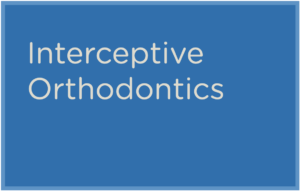What is Interceptive Orthodontics?
Interceptive Orthodontics could be called interventional orthodontics, as it is the orthodontic treatment that is done on children as a course-correction for growth and development gotten off track. Nature has a plan, and we plan to help!
Interceptive Orthodontics is also called early-phase orthodontics or phase-1 orthodontics, or orthotropic orthodontics. They all take advantage of a child’s youth and remaining growth availability. This is different in design and intention from Limited Orthodontics, which generally refers to braces and/or aligners used to straighten specific teeth but not to correct the bite.
What Appliances are used in Interceptive Orthodontics?
- Palatal expanders
- Lip bumpers
- Headgear
- Bite appliances
- Braces!
All of the above appliances (other than braces) are called Functional Growth Appliances.
What age should my child be evaluated?
We recommend that all children be evaluated for Interceptive Orthodontics as early as 2.5 years of age, but no later than age 7. Little problems on little people with little teeth are easier to manage than when they get older. And for many, starting young may have the added benefit of avoiding a second phase of orthodontics in the teenage years.
What is involved in an Interceptive Orthodontics evaluation?
This evaluation starts with a look at the structures of the face and mouth. Some things we look for include:
- spacing vs. crowding of teeth
- shape and size of the palate
- relationship between upper and lower jaw size and position
- flexibility vs. rigidity of the tongue and cheeks
In some cases, further evaluation of the swallow pattern and the head-on-neck posture is needed prior to forming a dental treatment plan. In those cases, we refer for Orofacial Myology and Integrative Postural Therapy evaluations.
How long does Interceptive Orthodontics take?
This depends entirely on the age a child starts. The best time is during the ages 5-9 while the primary molar teeth still have strong roots. While it is possible to work around the issue of molars that exfoliate (get loose and fall out) during interceptive orthodontics, this will require taking updated dental impressions and sending the appliance for modification/repair and may slow down the progress of the treatment.
For more information about the distinction between Interceptive Orthodontics (also called Orthotropics) and standard orthodontic care, visit Professor John Mew’s website at https://johnmeworthotropics.co.uk/.


